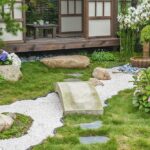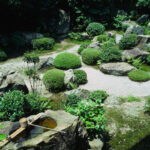Japanese garden design is a unique and complex art form that has been practiced for centuries. Rooted in ancient traditions and principles, Japanese gardens are known for their serene and harmonious beauty. The design of these gardens is carefully planned to create a tranquil space that reflects the natural world and offers a place for contemplation and meditation.
One of the key elements of Japanese garden design is the use of natural materials such as rocks, water, and plants. These elements are carefully chosen and arranged to create a sense of balance and harmony in the garden. Rocks are often used to represent mountains or islands, while water features such as ponds or streams symbolize rivers or oceans. Plants are chosen for their symbolic meanings, with traditional choices including bamboo, pine trees, and cherry blossoms.
In addition to the use of natural elements, Japanese garden design also incorporates man-made structures such as bridges, lanterns, and gates. These structures are carefully placed within the garden to create points of interest and enhance the overall aesthetic. Bridges are often used to symbolize the journey from the mundane world to a more spiritual realm, while lanterns provide light and guidance along the paths of the garden.
The layout of a Japanese garden is carefully planned to create a sense of flow and movement within the space. Paths meander through the garden, leading visitors on a journey through different areas and viewpoints. The use of winding paths and hidden corners creates a sense of discovery and surprise, encouraging visitors to explore the garden and discover its hidden treasures.
Japanese garden design is also heavily influenced by the principles of Zen Buddhism, which emphasize simplicity, serenity, and mindfulness. Gardens are designed to create a sense of peace and tranquility, with carefully chosen elements that evoke a sense of calm and reflection. The overall goal of a Japanese garden is to provide a space for meditation and contemplation, allowing visitors to connect with nature and find inner peace.
In conclusion, Japanese garden design is a rich and complex art form that has evolved over centuries. Rooted in tradition and influenced by principles of Zen Buddhism, these gardens are designed to create a sense of harmony and balance, offering a space for contemplation and meditation. By carefully selecting natural elements, incorporating man-made structures, and creating a sense of flow and movement, Japanese garden designers create beautiful and serene spaces that reflect the beauty of the natural world.
















